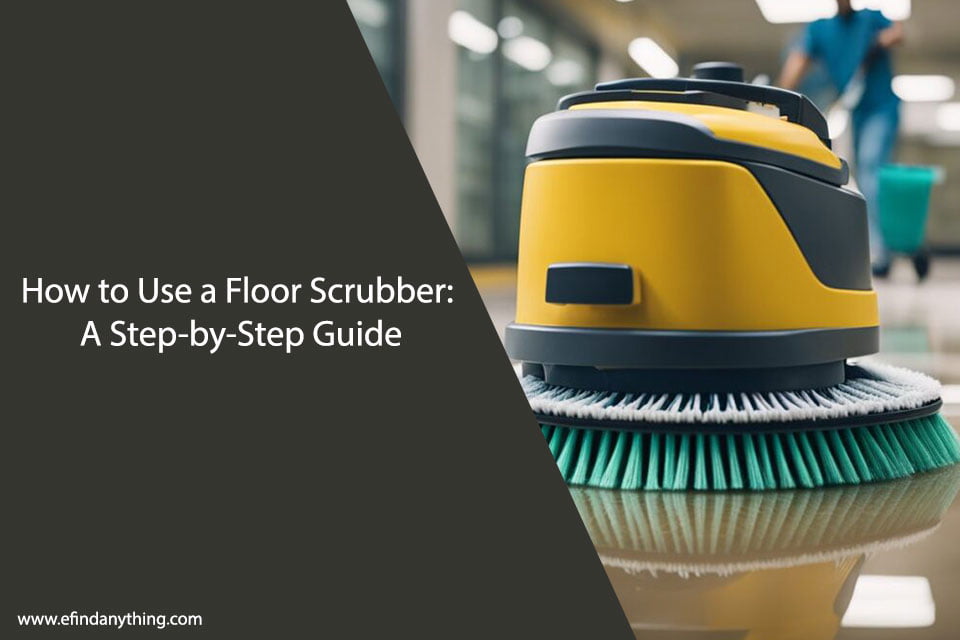Using a floor scrubber can be an efficient and effective way to clean large areas of flooring. However, if you’ve never used one before, it can be intimidating to get started. In this article, we’ll provide a step-by-step guide on how to use a floor scrubber, so you can confidently tackle your next cleaning project.
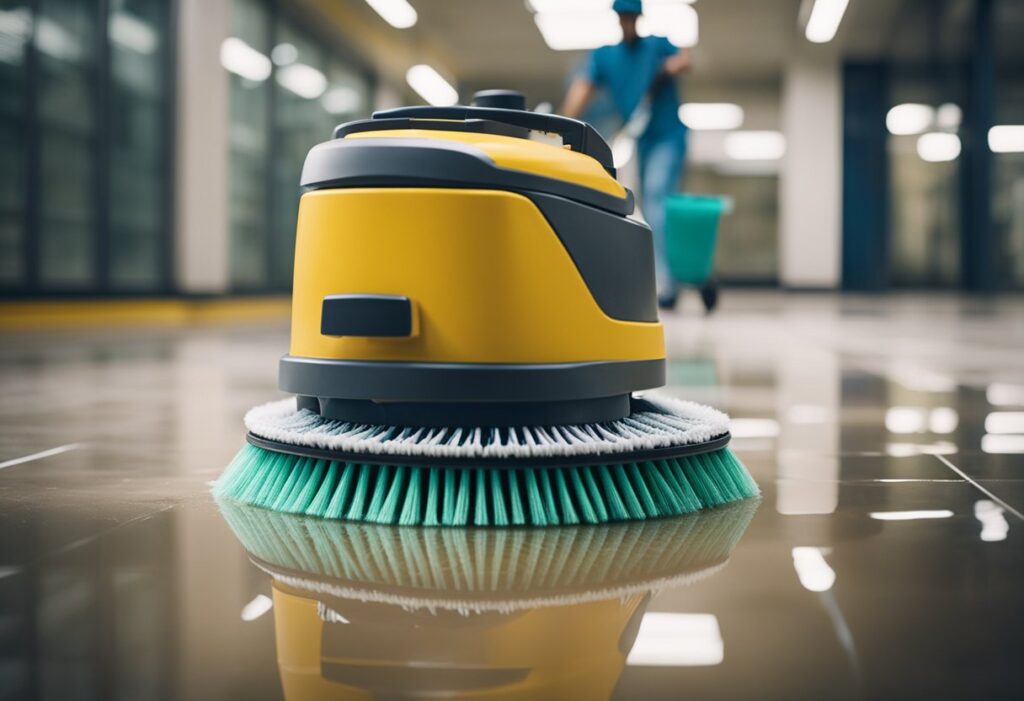
First, it’s important to understand the different types of floor scrubbers available. There are walk-behind scrubbers, which are typically used for smaller areas, and ride-on scrubbers, which are better suited for larger spaces. Once you’ve determined which type of scrubber you’ll be using, it’s time to get started with the cleaning process.
Table of Contents
Understanding Floor Scrubbers
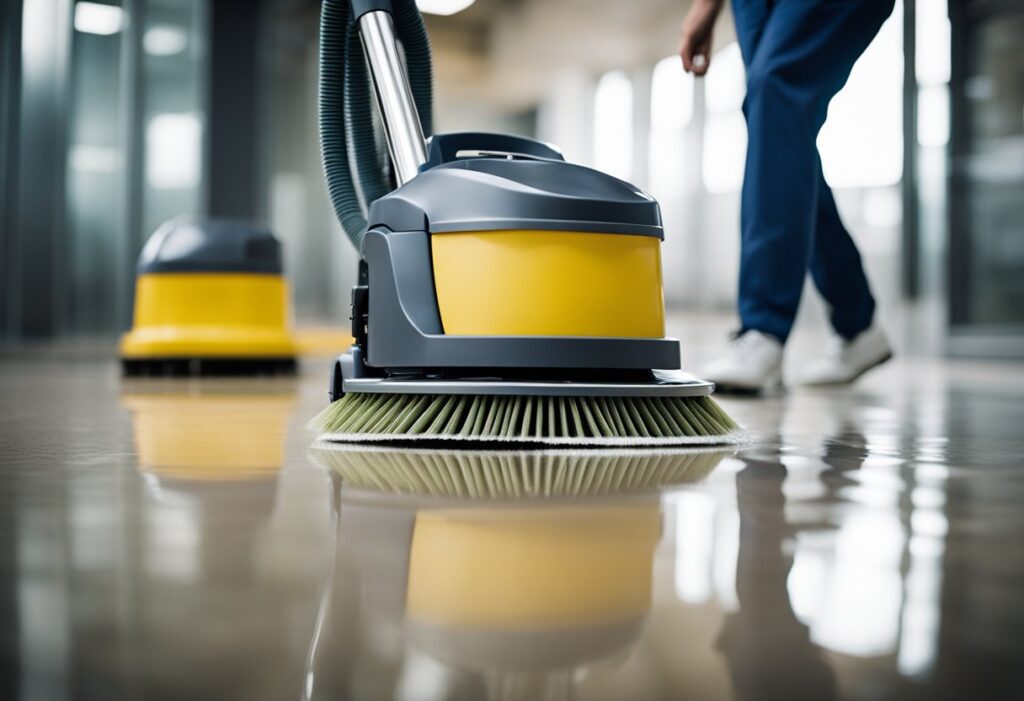
Types of Floor Scrubbers
When it comes to floor scrubbers, there are two main types: walk-behind and ride-on. Walk-behind scrubbers are more maneuverable and versatile, making them ideal for smaller spaces or areas with obstacles. Ride-on scrubbers, on the other hand, are more efficient and can cover larger areas in less time.
Another important factor to consider when choosing a floor scrubber is the type of brush or pad used. There are different types of brushes and pads for different surfaces and cleaning needs. For example, soft brushes are ideal for delicate surfaces like hardwood floors, while stiff brushes are better suited for tough stains and grime on concrete floors.
Key Components
Floor scrubbers consist of several key components, each of which plays a crucial role in the cleaning process. These include:
- Solution tank: This is where the cleaning solution is stored before being dispensed onto the floor.
- Scrubbing brush or pad: This is what actually scrubs the floor to remove dirt and grime.
- Squeegee: This component collects the dirty water and solution and deposits it into the recovery tank.
- Recovery tank: This is where the dirty water and solution are stored after being collected by the squeegee.
Other important features to look for when choosing a floor scrubber include the size of the cleaning path, the power source (battery, electric, propane), and the level of automation (manual vs. automatic). By understanding the different types of floor scrubbers and their key components, you can choose the right machine for your cleaning needs and achieve a clean and polished floor.
Preparation for Use
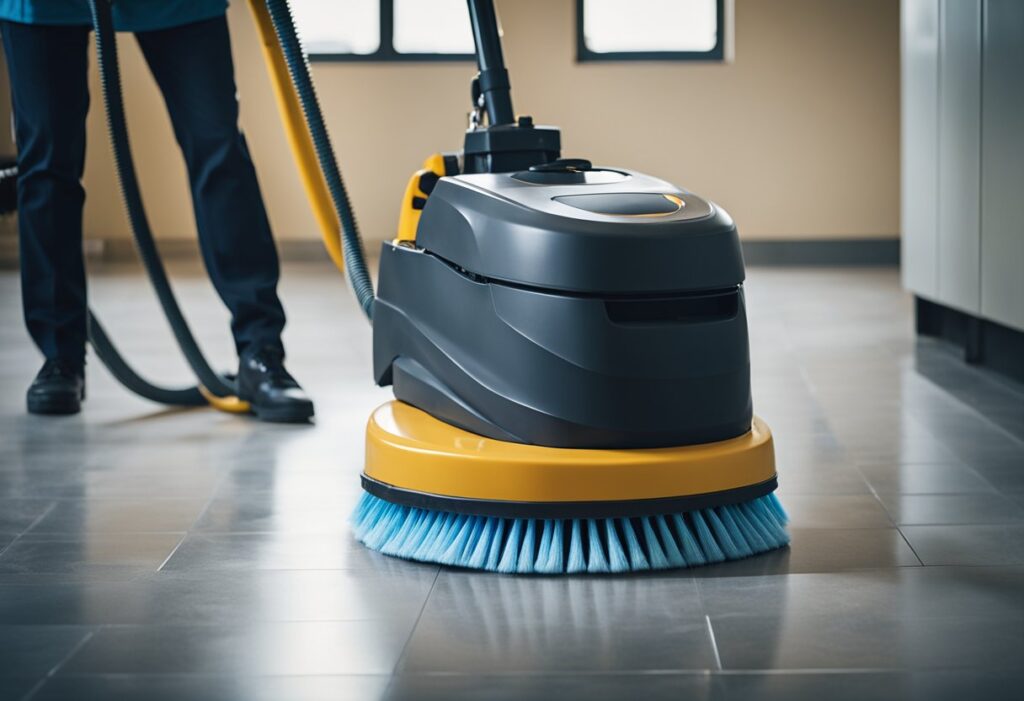
Assembling the Floor Scrubber
Before using the floor scrubber, we need to assemble it properly. We should refer to the manufacturer’s instructions and ensure that all parts are present and in good condition. We should also ensure that the machine is clean and free of any debris or dirt. Once we have assembled the machine, we should check that all the connections are secure and the machine is ready to operate.
Safety Precautions
It is important to take safety precautions when using a floor scrubber. We should wear appropriate personal protective equipment, such as gloves, goggles, and hearing protection. We should also ensure that the area is clear of any obstacles and that there are no people nearby who could be injured. We should always follow the manufacturer’s instructions and use the machine as intended.
Selecting Cleaning Solutions
Selecting the right cleaning solution is important for achieving the best results when using a floor scrubber. We should choose a cleaning solution that is appropriate for the type of flooring we are cleaning and the level of dirt and grime present. We should also ensure that the cleaning solution is compatible with the machine and that we follow the manufacturer’s instructions for use. It is important to use the correct amount of cleaning solution, as using too much can cause damage to the flooring and the machine.
Operating the Floor Scrubber
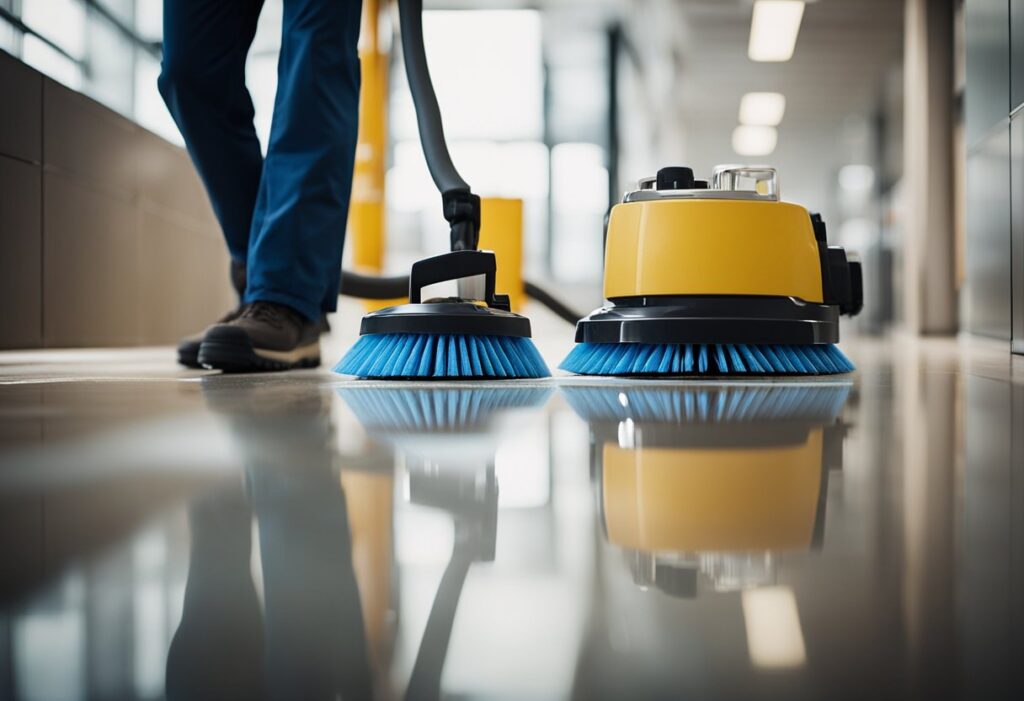
Filling Solution Tanks
Before operating the floor scrubber, we need to ensure that the solution tanks are filled with the appropriate cleaning solution. To fill the tanks, we first need to locate the solution tank caps, which are typically located on top of the machine. We then remove the caps and fill the tanks with the recommended amount of cleaning solution. It’s important to not overfill the tanks, as this can cause the machine to malfunction. Once the tanks are filled, we can replace the caps and ensure they are securely tightened.
Powering On the Machine
To power on the floor scrubber, we first need to locate the power switch, which is typically located on the control panel of the machine. We then press the power button to turn on the machine. Once the machine is on, we can adjust the speed and brush settings as needed. It’s important to note that we should never leave the machine unattended while it’s in operation.
Adjusting Settings
To adjust the speed and brush settings of the floor scrubber, we first need to locate the appropriate controls on the control panel. We can then adjust the settings as needed based on the type of flooring and level of dirt and grime. It’s important to ensure that the machine is set to the appropriate settings to avoid damaging the flooring or causing excessive wear and tear on the machine.
Overall, operating a floor scrubber requires attention to detail and proper maintenance to ensure that it operates effectively and efficiently. By following these simple steps, we can ensure that our floors are cleaned thoroughly and efficiently.
Effective Scrubbing Techniques
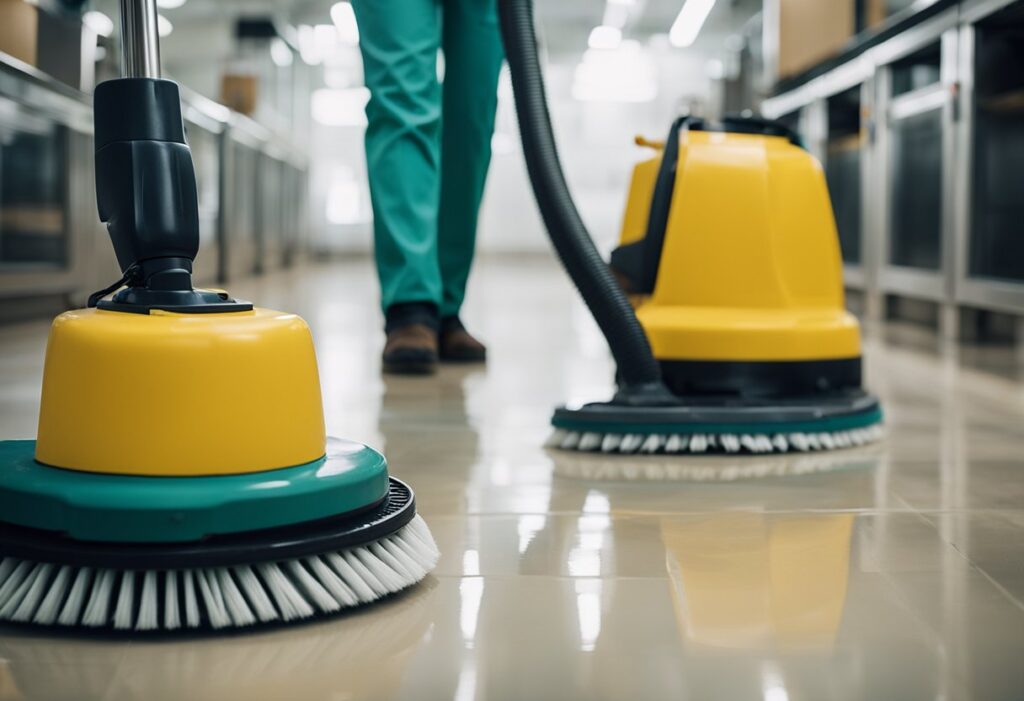
Handling and Maneuvering
When using a floor scrubber, it is important to have proper handling and maneuvering techniques in order to get the best results. We recommend that you always keep both hands on the machine and maintain a steady pace. Avoid jerky movements and sudden stops as this can cause streaks and uneven cleaning. Additionally, make sure to adjust the handle to a comfortable height to avoid straining your back.
Coverage Patterns
To ensure that you cover all areas of the floor, it is important to use effective coverage patterns. We recommend using a back-and-forth motion, overlapping each pass slightly, until the entire area has been covered. This technique ensures that you don’t miss any spots and that you achieve even cleaning across the entire surface.
Dealing with Tough Stains
Even with regular cleaning, tough stains can still appear on the floor. When dealing with tough stains, we recommend using a more concentrated cleaning solution and allowing it to sit on the stain for a few minutes before scrubbing. Additionally, using a scrub brush attachment can help to agitate the stain and make it easier to remove, especially if you’re using a nilfisk sc100. For particularly stubborn stains, multiple passes may be necessary.
By following these effective scrubbing techniques, you can achieve a clean and polished floor with your floor scrubber. Remember to always read the manufacturer’s instructions and take proper safety precautions when using the machine.
Maintenance and Care
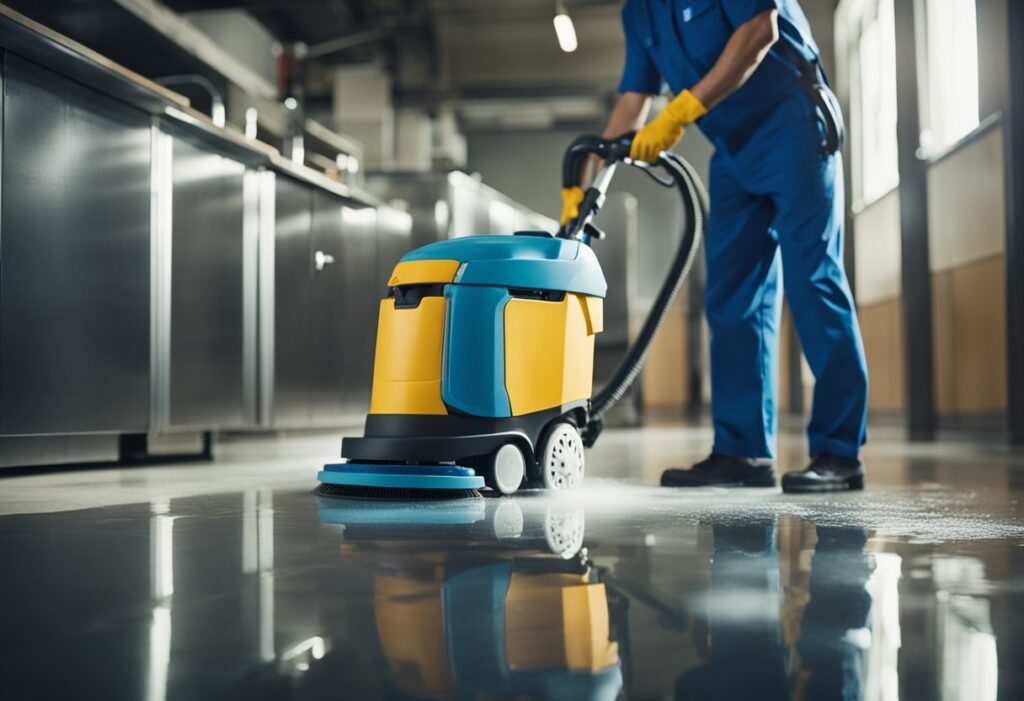
Daily Cleaning of the Machine
To ensure the longevity and optimal performance of your floor scrubber, it is essential to perform daily cleaning tasks. Start by emptying the recovery tank and rinsing it thoroughly with clean water. Next, remove and clean the squeegee assembly, brush, and pad holders. Use a soft-bristled brush to remove any debris or dirt from the machine’s exterior surfaces. Finally, wipe the machine down with a clean, damp cloth to remove any remaining dirt or debris.
Regular Maintenance Tasks
In addition to daily cleaning, regular maintenance tasks should be performed to keep your floor scrubber in top condition. Check and replace the brushes, squeegee blades, and vacuum hoses as needed. Inspect the machine’s battery and charger regularly, and ensure that they are functioning correctly. Check the machine’s hydraulic system for any leaks or damage, and repair or replace any parts as necessary.
Troubleshooting Common Issues
Even with proper maintenance and care, floor scrubbers may experience issues from time to time. Here are some common problems and their solutions:
- Machine not starting: Check that the battery is fully charged and connected properly. If the battery is functioning correctly, check the fuse and replace it if necessary.
- Uneven cleaning: Ensure that the brushes, squeegee, and pad holders are properly installed and adjusted. Check that the machine’s solution flow rate is correct for the surface being cleaned.
- Squeegee streaking or leaving water behind: Check that the squeegee blades are clean and free from damage. Adjust the squeegee height and angle to ensure proper contact with the floor.
By following these maintenance and care guidelines, you can keep your floor scrubber running smoothly and effectively for years to come.
Storage and Transportation
Proper Storage Practices
When it comes to storing your floor scrubber, it is important to follow proper practices to ensure that it remains in good condition. First and foremost, always make sure to clean the machine thoroughly before storing it. This will prevent any dirt or debris from accumulating and potentially damaging the machine.
Next, make sure to store the scrubber in a dry and cool area. Moisture and heat can cause damage to the machine, so it is important to avoid storing it in areas that are prone to these conditions. Additionally, make sure to cover the machine with a protective cover to prevent any dust or debris from settling on it.
Transporting the Floor Scrubber
Transporting your floor scrubber can be a delicate process, but with proper precautions, it can be done safely and efficiently. When transporting the machine, make sure to secure it properly to prevent any damage or movement during transit.
If you are transporting the machine in a vehicle, make sure to properly secure it with straps or other restraints to prevent it from shifting during transit. Additionally, make sure to remove any detachable parts and store them separately to prevent damage.
When transporting the machine on foot, make sure to use a dolly or other wheeled device to prevent strain on your back and to ensure that the machine is properly supported during transport.
By following these proper storage and transportation practices, you can ensure that your floor scrubber remains in good condition and is ready to use whenever you need it.
Frequently Asked Questions
What are the steps for operating a walk-behind floor scrubber?
To operate a walk-behind floor scrubber, first, fill the solution tank with water and the appropriate cleaning solution. Then, adjust the brush height and turn on the machine. Slowly move the machine forward while pressing the scrub button, and release the button when moving backward. After scrubbing, turn off the machine, drain the dirty water, and rinse the scrubber before storing it.
Can you explain the proper technique for using a ride-on floor scrubber?
To use a ride-on floor scrubber, first, make sure the scrubber is properly charged and filled with the appropriate cleaning solution. Then, adjust the brush height and turn on the machine. Slowly drive the machine forward while pressing the scrub button, and release the button when moving backward. After scrubbing, turn off the machine, drain the dirty water, and rinse the scrubber before storing it.
What is the best way to maintain a floor scrubber to ensure its longevity?
To maintain a floor scrubber, it is important to regularly clean and inspect the machine. This includes emptying and cleaning the solution and recovery tanks after each use, checking and replacing brushes and pads as needed, and lubricating moving parts. Additionally, it is important to follow the manufacturer’s recommended maintenance schedule and store the machine in a dry, cool place.
Is it necessary to sweep the floor before using an auto scrubber machine?
Yes, it is necessary to sweep the floor before using an auto scrubber machine. Sweeping removes loose debris and dirt, which can clog the machine’s brushes and decrease its effectiveness. Additionally, sweeping helps to prevent damage to the machine’s brushes and pads.
How do you achieve optimal results when using a floor scrubber on tile surfaces?
To achieve optimal results when using a floor scrubber on tile surfaces, it is important to use the appropriate cleaning solution and brush or pad. Additionally, it is important to adjust the brush height to ensure proper contact with the tile surface. Finally, it is important to follow the manufacturer’s recommended cleaning procedures and rinse the floor thoroughly after scrubbing.
What are the safety precautions to consider while operating a commercial floor scrubber?
When operating a commercial floor scrubber, it is important to wear appropriate personal protective equipment, such as gloves and safety glasses. Additionally, it is important to follow the manufacturer’s recommended safety procedures, including keeping hands and feet away from moving parts and turning off the machine before making adjustments or performing maintenance. Finally, it is important to be aware of the machine’s surroundings and avoid obstacles and hazards.

